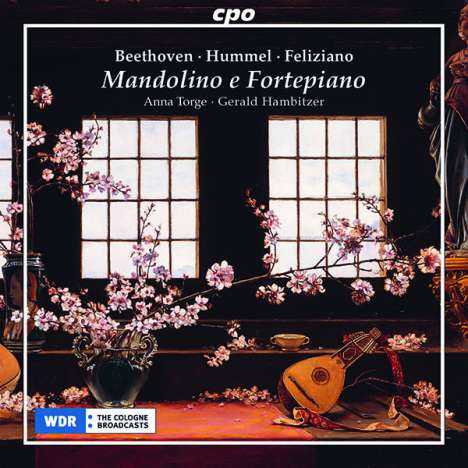Mandolino e Fortepiano - Sonatas & Variazioni auf CD
Mandolino e Fortepiano - Sonatas & Variazioni
Herkömmliche CD, die mit allen CD-Playern und Computerlaufwerken, aber auch mit den meisten SACD- oder Multiplayern abspielbar ist.
Lassen Sie sich über unseren eCourier benachrichtigen, falls das Produkt bestellt werden kann.
Hummel: Grande Sonata C-Dur op. 37
+Leone: Sonate A-Dur Nr. 2 op. 2
+Feliziano: Sonata con Variazioni C-Dur
+Beethoven: Rondo D-Dur; Andante con Variazioni D-Dur; Sonatinen C-Dur & c-moll; Adagio ma non troppo Es-Dur
- Künstler:
- Anna Torge (Mandoline), Gerald Hambitzer (Hammerklavier)
- Label:
- CPO
- Aufnahmejahr ca.:
- 2014
- UPC/EAN:
- 0761203511228
- Erscheinungstermin:
- 18.9.2018
Ähnliche Artikel
Anmutige Mandoline II
Nach „Mandolino e Violino in Italia“ kommt jetzt „Mandolino e Fortepiano“ mit der erfolgreichen Mandolinistin Anna Torge, die vor allem durch ihr überraschend kantables, feinst artikuliertes, melodisch und harmonisch bewusstes Spiel, wie dies auf einem Zupfinstrument äußerst selten der Fall ist, fasziniert“ (Neue Musikzeitung 05 / 2018). Bei der Werkauswahl der neuen CD kommt eine vierchörige Mandoline zum Erklingen. Der elegant-empfindsame Klang des Instruments entstand durch Darm-, Kupfer- und silberumsponnene Saiten, welche mit einem Federkiel oder Plektrum aus Rinde angeschlagen wurden. 1804 komponierte Johann Nepomuk Hummel seine festliche und anmutige Grande Sonata, die heute als das letzte große Werk der sogenannten klassischen Hochblüte der Mandoline angesehen werden kann. Die Sonate von Gabriele Leone wird die Zuhörer in die Klangwelt der galant-empfindsamen Zeit führen und die hochentwickelte Spielkunst dieser Zeit aufzeigen. Die Verknüpfung der europäischen Adelshäuser führte zur Verbreitung und Beliebtheit der Mandoline in allen Ländern des Kontinents. So verwahrt die Nationalbibliothek in Lissabon einige Sonaten für Mandoline und Klavier, die von dem portugiesischen Komponisten Porto Feliziano stammen. Und auch der junge Beethoven, angetan von der Schönheit und von dem anmutigen Mandolinenspiel der Comtesse Josefine Clary-Aldringen, schrieb reizvolle Werke für Mandoline und Tasteninstrument.
Product Information
Mandolin Charm II
Following Mandolino e Violino in Italia we are now releasing Mandolino e Fortepiano with the acclaimed mandolin virtuoso Anna Torge, who »inspires fascination above all with her surprisingly cantabile, most finely articulated, melodically and harmonically intelligent playing, as is extremely rarely the case on a plucked instrument« (Neue Musikzeitung 5 / 2018). A mandolin with four courses is used for the selection of works heard on this CD. The elegant and sensitive sound of the instrument was produced with gut, copper, and silver-plated strings plucked with a quill or plectrum made of bark. In 1804 Johann Nepomuk Hummel composed his festive and graceful Grand Sonata, which today may be regarded as the last great work of what is known as the classical zenith of the mandolin. The Sonata by Gabriele Leone will transport listeners to the sound world of the galant sensitive style and demonstrate the highly developed performance artistry of this period. The mandolin’s association with the network of Europe’s noble families led to its dissemination and popularity in all the countries of the Continent. For example, the National Library in Lisbon contains in its holdings Sonatas for Mandolin and Piano by the Portuguese composer Porto Feliziano. Even the young Beethoven, attracted to the beauty and charming mandolin playing of Comtesse Josefine Clary-Aldringen, wrote ravishing works for mandolin and keyboard.
Rezensionen
klassik-heute.de 12/2018: »Torge und Hambitzer präsentieren die gehaltvolle Kost ausnehmend geschmackvoll. Sie gestalten die Musik überaus geistvoll, mit einer splendiden Spiellaune und einer sehr natürlich und nie verkünstelt wirkenden Musikalität. Ein moderner Flügel würde das zarte Zupfinstrument, das deutlich mehr zu bieten hat als das Volksmusikgeschrammel, auf das es gerne reduziert wird, wohl platt machen. Die größte Überrauschung auf dieser CD sind Werke von Beethoven, der - man höre und staune - auch für diese Kombination geschrieben hat. Spätestens hier lauscht der Kenner andächtig - und ist überzeugt.«Disk 1 von 1 (CD)
Große Sonate C-Dur op. 37
-
1 Johann Nepomuk Hummel: 1. Allegro con spirito
-
2 Johann Nepomuk Hummel: 2. Andante moderato - Siciliano
-
3 Johann Nepomuk Hummel: 3. Rondo: Allegretto
Sonate Nr. 2 A-Dur op. 2
-
4 Gabriele Leone: 1. Con bizzaria
-
5 Gabriele Leone: 2. Languido
-
6 Gabriele Leone: 3. Finale con Chiaro
Sonate mit Variationen C-Dur
-
7 Porto Feliziano: 1. Allegro moderato
-
8 Porto Feliziano: 2. Siciliana: Larghetto
-
9 Porto Feliziano: 3. Thema: Andantino
-
10 Porto Feliziano: 4. Variation 1
-
11 Porto Feliziano: 5. Variation 2
-
12 Porto Feliziano: 6. Variation 3
-
13 Porto Feliziano: 7. Variation 4
-
14 Ludwig van Beethoven: Rondo D-Dur (Allegretto) (rekonstr. von Frank Löhr)
Andante mit Variationen D-Dur
-
15 Ludwig van Beethoven: 1. Thema: Andante
-
16 Ludwig van Beethoven: 2. Variation 1
-
17 Ludwig van Beethoven: 3. Variation 2
-
18 Ludwig van Beethoven: 4. Variation 3
-
19 Ludwig van Beethoven: 5. Variation 4
-
20 Ludwig van Beethoven: 6. Variation 5
-
21 Ludwig van Beethoven: 7. Variation 6
-
22 Ludwig van Beethoven: Sonatine c-moll (Adagio)
-
23 Ludwig van Beethoven: Sonatine C-Dur
-
24 Ludwig van Beethoven: Adagio ma non troppo Es-Dur













